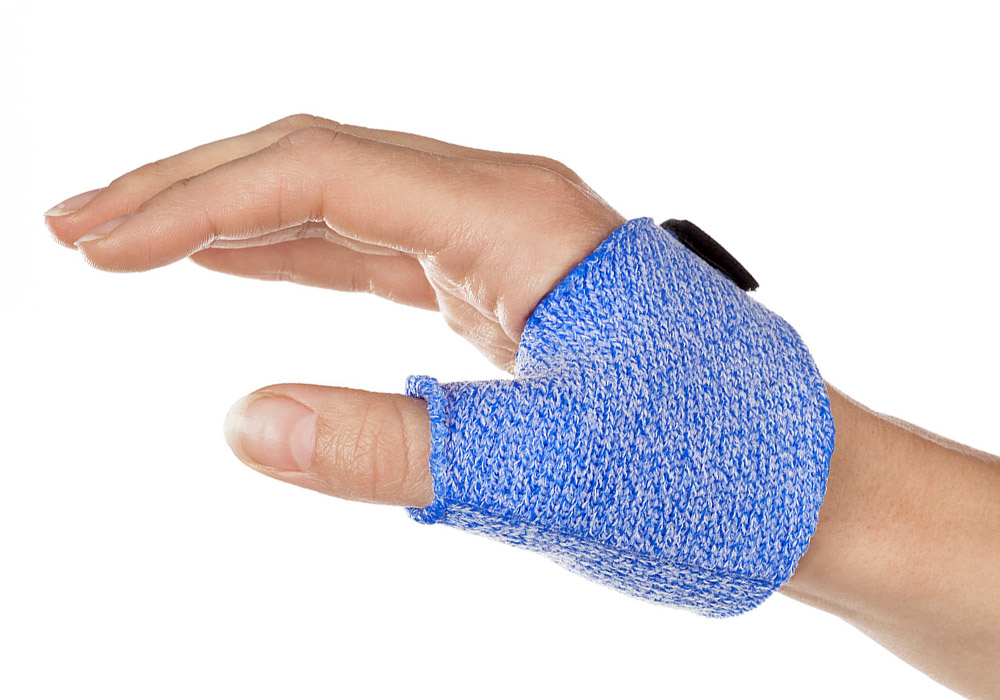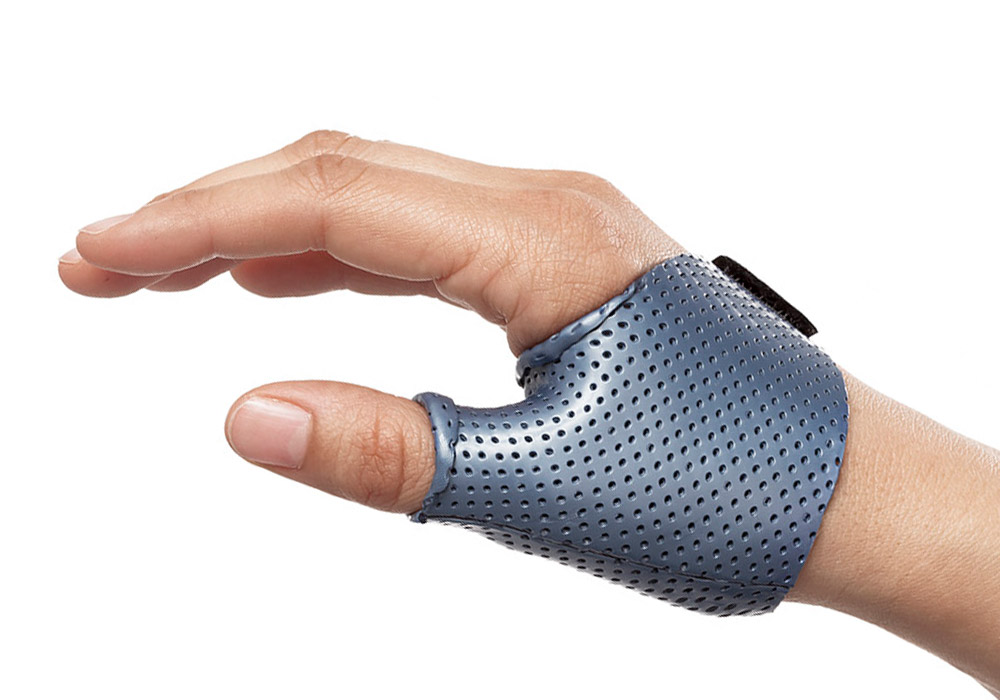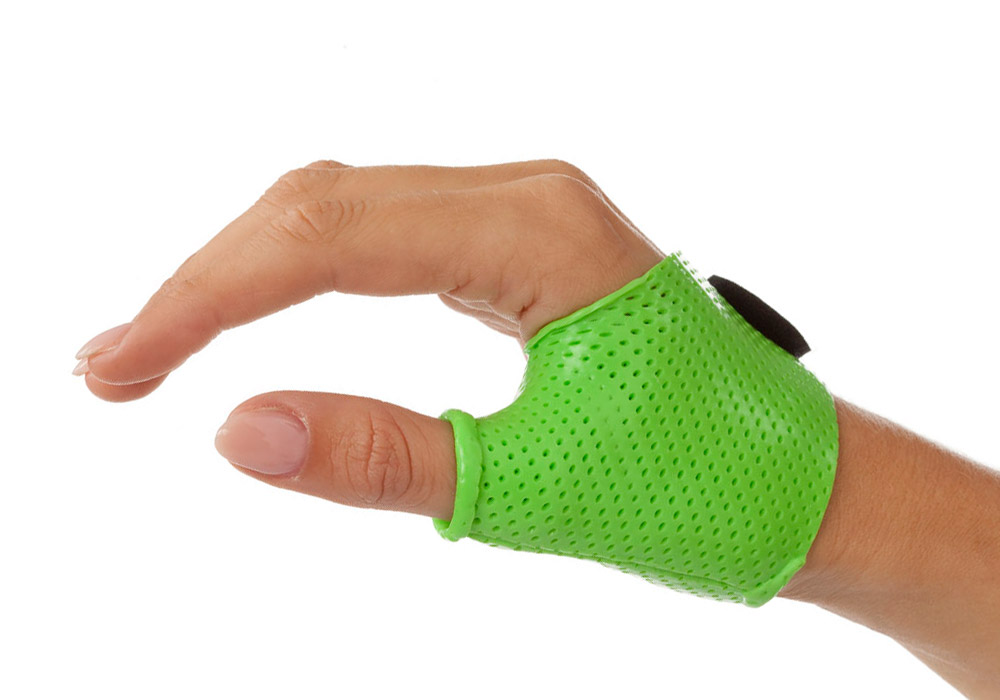The Short Thumb Opponens Orthosis
6 Key factors for thumb splinting
The short thumb opponens orthosis is an important intervention for several hand conditions, such as:
- Ulnar and radial collateral ligament (UCL and RCL) injuries
- Osteoarthritis (OA) and Rheumatoid arthritis (RA)
- Generalized thumb pain
- Median nerve palsy
- Thumb fractures

Short Thumb Opponens Orthosis in Orfilight Black NS.
There are multiple designs for the fabrication of this important orthosis. In fact, every therapist has their favorite design and thermoplastic material. Therapists may choose one specific design and material for patients with thumb OA and another design and material for a UCL injury.
We list 6 key factors to consider when fabricating a short thumb opponens orthosis:
2. Size and shape of the patient’s hand
3. Thumb joints to be included
4. Daily activities and work requirements of the patient
5. Wearing protocol/duration of wear
6. Patient/therapist preference
1. Positioning of the thumb
The positioning of the thumb in the orthosis is determined by the clinical diagnosis:
- Reduction of pain at the base of the thumb caused by motion (as seen in OA or RA): Position the thumb in palmar abduction and opposition.
- Immobilization following fracture of the proximal and/or distal phalanx: Position the thumb in full extension.
- Shortened tissue length in the first web space after an injury: Position the thumb in wide abduction.
Knowing the clinical diagnosis will always guide you to the proper positioning for each individual patient.
2. Size and shape of the patient’s hand
The size of the patient’s hand and its shape can help you determine which material and which thickness to select.
- Size: Larger hands may require 2.0 mm (1/12”) or even 3.2 mm (1/8″) thickness while smaller hands might do well with 1.6 mm (1/16″) or Orficast (More).
- Bone definition: Hands with very prominent bones might do best with highly conforming materials such as our Orfilight (NS) products or our elastic based products.
- Muscle tone: Hands with high tone and significant contractures generally require stronger and more rigid materials like Orfit Eco or Orfit Eco Black NS.

The size and shape of the patient’s hand will help you choose the correct material and thickness.
3. Thumb joints to be included
The thumb includes three joints: the carpometacarpal CMC) joint, the Metacarpal- phalangeal (MCP) joint, and the interphalangeal (IP) joint. Whether your patient has a thumb fracture or osteoarthritis of the CMC joint, make sure that your orthosis provides the immobilization required for the specific diagnosis involved and only immobilizes the necessary joints.
A short thumb opponens orthosis may immobilize:
- Only the CMC joint
- The CMC and MCP joints
- All three joints (CMC, MCP, and IP)
It all depends on the specific diagnosis and your specific patient.
4. Daily activities and work requirements of the patient
The daily activities and work requirements of the individual patient may help you determine whether to fabricate a volar, dorsal, radial based or circumferential design.
Does the patient need to wear gloves? Consider a very thin material (such as Orficast or Orficast More) in order to allow wearing the orthosis under work gloves or during sports activities.
Will the patient need to don and doff the orthosis often during the day? Make sure the straps are well attached so they do not come off when pulled.

Carefully consider the patient’s daily activities and work requirements.
5. Wearing protocol/duration of wear
How long will your patient need to wear this orthosis? What is the recommended wearing schedule? Inform your patient of this wearing schedule protocol, especially if the orthosis is to be worn only during the day or only during the night. Have your patient repeat the instructions back to you in their own words and even have them sign an instruction sheet in acknowledgment that they understand the recommended wearing schedule so there are no misunderstandings.
If the orthosis will be fabricated for a patient who lives quite far from the clinic, you might need to provide additional straps or instructions on what to do if the orthosis feels too tight or too loose after time. Schedule a follow-up appointment so that you can check the fit and make any necessary adjustments.
Will your orthotic design and thermoplastic material hold up for the recommended duration of wear? Most orthoses will last for the duration of the rehabilitation period (3-6 months). If you suspect your patient will need their orthosis longer than this time frame, you might need to use a stronger material or a different design. Always make sure the patient has a follow-up for check-ups.
6. Patient/therapist preference
We want to believe that our patients will always follow our advice and wear the orthosis as outlined. But if possible, let your patient have a choice in the color of the straps or the thermoplastic materials in order to help with their compliance and adherence to the wearing schedule.
But remember to choose a material that you like to work with! Pick a material that has high conformity and is easy to mold around the thumb and thenar muscles. This will create a conforming and comfortable orthosis that helps your patient stick to his/her wearing schedule for best results.
Conclusion
The short thumb opponens orthosis appears to be a simple design, yet it involves complex fitting and critical thinking. Keep these 6 factors in mind during the orthotic fabrication process to create effective and comfortable thumb orthoses for all your patients.



